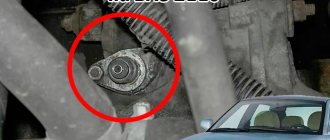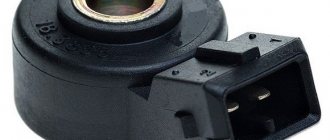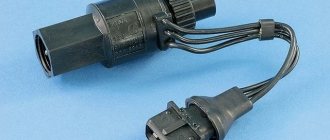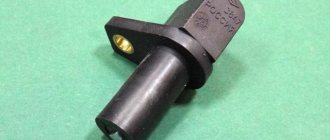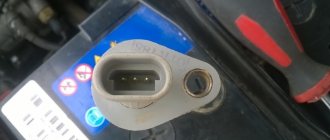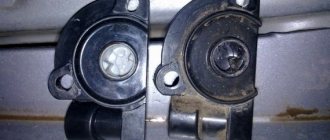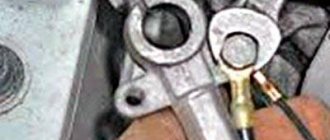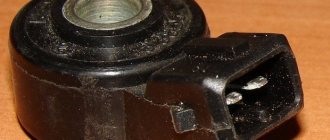Sensors in the structure of cars are a kind of spies, reporting to the “senior” components of the car and directly to the driver some information about the functioning of a particular system. Thanks to this data, the previously noted recipients make specific decisions to organize the further operation of the vehicle. Such spies are installed in the design of any car and, moreover, in considerable quantities. One of the main ones is, of course, the speed sensor. Want to know more about him? Then be sure to read today’s article, which describes in detail how the speed sensor of a modern car works, is repaired, and what is affected by it.
Speed sensor VAZ 2110 purpose
The VAZ 2110 speed sensor is responsible for the correct fuel supply, “sets” the ignition timing and controls the quality of the combustible mixture.
The sensor “collects” a lot of data for the injector (such as engine speed, speed, detonation level, etc.) and transmits digital signals to the electronic unit. In turn, all data is checked here and appropriate adjustments are made to the operation of the injector.
Diagram and pinout of DS Priora
Three wires are connected to the DS Priora plug. One of them is positive 12V, the second or central one is the signal wire that supplies impulses to the control unit, and the third is ground.
The speed sensor power supply circuit is shown in the photo below.
The DS pinout diagram on a Priora may be needed when replacing a plug or checking the incoming power.
The principle of operation of the speed meter for the VAZ 2110 injection engine
So, why is the device in question located vertically if the axis of rotation of the manual transmission drive shaft is precisely horizontal? The fact is that the rotating element of the device is connected to the gearbox shaft not directly, but through a transition rotation transformer. Using a worm gear, horizontal rotation with a certain gear ratio is transformed to the mechanical part of the speed sensor.
The shaft end of the electronic part of the sensor, which we can see from the outside of the gearbox, is inserted into the adapter receiving sleeve.
The system operates according to the Hall principle. The moving parts of the Hall elements are located on the shaft inside the housing. When rotating, the counter part (in the form of an inductor) generates pulses synchronous with the rotation of the wheel. Since the circumference of the tire is known, the electronic module converts each revolution into a distance traveled. This is how mileage is calculated. It remains to divide this figure by a unit of time, and we get the speed of the car at any time.
Important! Information for those who like to change their shoes to non-standard tires. By installing tuning wheels and tires with a dimension difference of more than 3%, you do not just create additional load on the suspension elements. The algorithm for calculating the speed of movement is disrupted: the crankshaft, camshaft and speed sensors become desynchronized. As a result, the ECU incorrectly forms the composition of the fuel mixture and makes errors in setting the ignition timing. That is, the sensor does not operate normally (but there is no damage).
Types of speed sensors, their differences. Where is the speed sensor located?
- Electronic 6-pulse sensors are equipped with cars with injection engines, launched into series since 2006.
- On carburetor Samaras you can sometimes find 10-pulse EMF.
Until 2006, VAZ cars used mechanical devices in the form of special inserts between the speed indicator cables and the gearbox gear outputs.
The key difference between different types of EMF is the absence of wires and connecting connectors. For example, GM or Yantar systems are equipped with products with round (oval) ports. At the same time, Bosh uses wireless versions with square connectors.
On the VAZ-2110 (2111, 2112), speed sensors are mounted on the gearbox housings slightly to the right along the route, directly next to the oil control dipstick.
The device is easy to find by looking in the area of the right CV joint.
On the VAZ-2115, the electronic device is mounted on top of the front part of the gearbox (along the way) directly above the differential. The product with the connected cable is secured with one bolt on the box body.
All instruments on the VAZ 10 that indicate the speed of the vehicle are pointers, and signs of a malfunction are determined by deviations from the norm of the speedometer needle. If the speedometer is faulty, the arrow when the car is moving:
- does not deviate from zero, that is, does not show speed at all;
- stuck in one position, does not move in any direction;
- jumps, sharply changing readings, while the displayed speed does not correspond to reality.
There are other signs of a faulty speedometer, for example, the device works on a cold engine, and its readings correspond to the norm. As the engine warms up completely, the needle freezes and stops moving.
The main reason why the speedometer on a VAZ-2110 injector does not work is contamination (oiling) of the speed sensor (DS), failure especially often occurs if oil from the gearbox or engine gets onto the DS (for example, there is a leak from the valve cover of the internal combustion engine ). There are also other reasons:
- the speedometer itself has failed;
- the speed sensor is broken (this part on AvtoVAZ cars is not highly reliable);
- there is no normal contact in the DS plug or a break (short circuit) of the wires has occurred;
- The speedometer drive gears installed in the gearbox broke.
Operating principle of the sensor
In most cars with a manual transmission, the speed sensor is installed in the area of the gearbox; if we consider a car with an automatic transmission (and not only), it is located closer to the output shaft of the box, and its task is to record the rotation speed of the specified shaft.
To deal with the problem and understand why the speed sensor (DS) is faulty, the first thing you need to understand is the principle of its operation. This is best done using the example of the popular domestic car VAZ-2114, since, according to statistics, it is on this car that speed sensors most often break down.
Speed sensors operating on the basis of the Hall effect generate a pulse signal, which is transmitted via a signal wire to the ECU. The faster the car goes, the more often impulses are transmitted. On a VAZ 2114, the number of pulses per kilometer is 6004. The speed of their formation depends on the speed of rotation of the shaft. There are two types of electronic sensors - with and without shaft contact. However, nowadays, as a rule, it is contactless sensors that are used, since their design is simpler and more reliable, so they have widely replaced older modifications of speed sensors.
To ensure the operation of the DS, it is necessary to place a master (pulse) disk with magnetized sections on the rotating shaft (bridge, gearbox, gearbox). When passing these areas near the sensitive element of the sensor, corresponding impulses will be generated in the latter, which will be transmitted to the electronic control unit. The sensor itself and the chip with the magnet are motionless.
Most cars equipped with an automatic transmission have two shaft rotation sensors installed on its components - primary and secondary. Accordingly, the speed of the vehicle is determined by the speed of rotation of the secondary shaft, therefore another name for the automatic transmission speed sensor is secondary shaft sensor . Typically, these sensors operate on the same principle, but have design features, so in most cases their mutual replacement is impossible. The use of two sensors is due to the fact that, based on the difference in the angular speeds of rotation of the shafts, the ECU makes a decision to switch the automatic transmission to one gear or another.
Signs of a malfunction speed sensor VAZ 2110
Typical signs of a malfunctioning speed sensor on a VAZ 2110 car are as follows:
- unstable operation and incorrect speedometer and odometer readings;
- cessation of stable engine operation at idle;
- errors generated by the computer (P0500 – no sensor signal, P0503 – intermittent sensor signal).
The problems listed above may result from:
- poor contact in the sensor connector due to contamination;
- violation of the integrity of the wiring from the sensor to the ECU;
- mechanical failure of the DS drive (in older VAZ 2110 models).
Speedometer malfunctions VAZ 2110 carburetor
On early 2110 cars with a carburetor, the speedometer needle is driven from the gearbox by a mechanical cable, and it is much easier to determine the cause of the malfunction here than in an electronic circuit. Checking the serviceability of the speedometer cable is simple: it must be disconnected from the gearbox - if the tetrahedron at its end is intact, then everything is in order in this connection.
Next, we take the tip of the cable with our fingers and try to twist it; if there are no breaks in the cable, the speedometer needle should begin to move (rise). If the vehicle rotates too freely with its fingers, the cable is most likely broken. To check the tens mechanical speedometer itself, you need to remove the instrument cluster.
If this option does not help you, look at the knock sensor of the VAZ 2110, this may be the reason.
Causes of malfunction of the speed sensor
The absence of speedometer readings does not mean failure of the device. Although, to buy a speed sensor for a “ten”, it is enough to spend a small amount, but it will be very disappointing that the fact of replacing the speed sensor will not give the desired effect. And the reasons may be the following:
- The presence of dirt, dust and oil smudges on the speed sensor, a video on replacing which can be found on the Internet. They form on the body of the product during vehicle operation. To prevent the product in this case, you just need to clean the device.
- Unstable contact of the product connector and broken wiring.
- Sometimes the defect is of a purely mechanical nature, which consists of banal defects in the cable of the instrument speed indicator - speedometer.
The following options are possible here:
1. Complicated uneven movement of a braided cable, which is caused by cable defects - burrs or ruptures of the metal strands of the cable. They can significantly affect the functionality of the sensor drive. 2. Increased cable speed.
Checking the device for serviceability:
- We hang the front wheel of the vehicle on a jack.
- We disconnect the wire contact from the product and connect a digital multimeter or similar device to it
- Making rotational movements with the hanging wheel at low speed, we measure the pulse flow signal from the connector. The functionality test begins with checking the grounding and power supply of the electrical circuit.
- We remove the device from its seat.
- We connect the device for measuring voltage to the output contacts.
- By turning the speed sensor drive, we measure its potential difference.
- The output should produce data in which, as the rotor speed increases, the frequency and voltage of the output power increases.
The functionality of the device is considered satisfactory if, during diagnostics, it shows the frequency and voltage parameters at the output contact. Otherwise, replacing the speed sensor of the VAZ “Ten” cannot be avoided.
Description of DS
As we have already said, the main purpose of the speedometer drive sensor is to accurately determine the speed of the vehicle. Thanks to this device, the model can always know at what speed his car is moving. As for the varieties, DS can be of the contact or non-contact type. Today, most of our compatriots prefer contactless options. Contact DS, despite all the advantages, have one significant drawback - they are prone to contamination, which in turn will lead to inaccuracy of the displayed readings.
Design and principle of operation
Structurally, according to the diagram, this part consists of:
- speedometer drive;
- housings;
- as well as the controller itself with a connector for connecting to the on-board network.
As for the principle of operation, it is based on measuring the frequency level of signals from the controller, which is located on the gearbox housing or transfer case. At the output of the device, while driving, rectangular pulses are formed, the minimum value of which should be at least 1 volt, and the maximum value should be at least 5 volts.
According to international standards, the controller must generate about 6 thousand such pulses over one kilometer. The pulses themselves are subsequently converted into current, which is measured by a magnetoelectric device. It should be noted that the current value directly depends on the number of signals supplied per certain unit of time. That is, this value will be directly proportional to the speed of the vehicle.
In addition, thanks to the electronic circuit installed in the dashboard, the operation of the stepper motor is ensured by counting incoming signals. The latter is designed to rotate the counter reels, after which it displays the relevant information on a small screen, where the total and daily mileage of the car is shown. If we are talking about daily mileage, then this value can be reset to zero if necessary.
Symptoms of a problem
If the DS for some reason fails, this will lead to the control unit being unable to determine the speed of movement. However, this is not the only problem, since malfunctions in the performance of the power unit may also occur.
We suggest that you familiarize yourself in more detail with the signs of a malfunction, by which you can determine the failure of the DS:
- the speedometer on the dashboard has either stopped working altogether or displays incorrect readings;
- malfunctions appear in engine operation, in particular at idle speed;
- fuel consumption increased;
- engine performance has deteriorated, the power unit cannot reach the required speed;
- the engine may stop spontaneously while idling, in particular when the driver tries to press the clutch to change gear;
- if the car is equipped with an on-board computer, a Check indicator may appear on the dashboard;
- if the car is equipped with an electric power steering, this unit may also fail;
- in some cars, for example, Lada Kalina, failure of the diesel engine can also lead to increased sensitivity of the fuel level controller in the gas tank (the author of the video is the Autoelectrics HF channel).
Some recommendations
- The search for the cause of the speedometer's inoperability should begin with an external inspection of the DS and the wires going to it. Wires often break in close proximity to the plug.
- If the speed sensor is covered with a layer of dirt or oily, you need to remove it, wipe it, reinstall it and check the speedometer readings again. Perhaps after this the instrument needle will again begin to show speed normally.
- If you cannot figure out the problem yourself, you should contact an electrician at a car service center.
Speed sensor
Carburetor models use a cable mechanical speedometer system, so there is no speed sensor. It's simply not needed.
Malfunction in the instrument cluster
Often the speedometer stops working due to a malfunction of the instrument panel itself. The easiest way to check this is to temporarily connect a known working panel. It is also worth checking the reliability of the contacts on the back of the dashboard. You can also check the vehicle speed readings on the on-board computer.
If the dashboard was tuned (disassembled), then the arrow motor may have been damaged during the work, or the speed arrow is set too deep (the arrow touches the panel trim).
Have you encountered speedometer problems? How did you manage to solve it? Let us remind you that solutions to other faults can be found in the category repair and operation of Lada Granta, Lada Kalina or Lada Priora.
Share on social networks:
Found an error? Select it and press Ctrl+Enter..
Source
Why does the VAZ 2110 speed sensor fail?
The reasons are mechanical and electrical. Let's list each one separately.
Mechanical reasons include:
- wear of gear teeth both on the manual transmission shaft and on the adapter - speed transformer;
- the appearance of play in the connection between the transformer shaft and the sensor itself;
- displacement or loss of the Hall element on the moving part;
- contamination of a pair of Hall elements inside the housing;
- physical damage to the shaft or housing.
Electrical reasons:
- failure of electronics (cannot be repaired);
- oxidation of connector contacts;
- chafing of device wires due to poor location;
- external interference from the injector control loop or high-voltage spark plug wire;
- interference created by non-standard electrical devices (such as a xenon driver or a security alarm unit).
How to check the speed sensor of a VAZ 2110
So, there are symptoms, but they are not clearly expressed. External inspection and testing of the connection cable showed that everything is in order. You can connect a diagnostic scanner to a car service center or garage and conduct a full hardware test.
But most VAZ 2112 (2110) owners prefer checking with a multimeter. The pinout of the VAZ 2110 speed sensor on the cable connector is as follows:
The supply contacts are marked “+” and “-”, and the central contact is the signal output to the computer. First, we check the power with the ignition on (you don’t have to start the engine). Then the sensor must be removed, power applied and a multimeter connected to the negative and signal contacts. When rotating the Hall sensor shaft manually, a working sensor will display voltage. The pulses can be taken with an oscilloscope: it’s even clearer.
Examination
If problems arise with the speed sensor, first of all you need to check the wiring for broken or oxidized contacts.
Since the wiring is not secured by anything, interruptions in the operation of the DS are often associated with the wires. If inspection shows that the wiring is normal, then it is necessary to diagnose the sensor itself.
You can check it using a multimeter turned on in voltage measurement mode. To do this, you don’t have to remove it from the car, but simply jack up the wheel and engage 4th gear.
The sensor itself has three terminals: the side ones are ground and the “positive” terminal for supplying voltage to the element. And the central one is pulse, through which signals are sent to the speedometer and ECU.
We connect the multimeter probes to the mass and pulse terminals. Then we ask the assistant to spin the wheel, and we ourselves look at the readings.
If during rotation the voltage value “jumps”, and the higher the speed, the more often “jumps” will occur, then the DC is working properly and the wiring should be checked.
In the same way, you can check the functionality of the new sensor after its installation.
Do I need to change
Not only the speedometer and odometer readings, but also the quality of the fuel mixture supplied to the cylinders, the idle speed of the vehicle, engine stability and fuel consumption depend on the information received by the ECU from the sensor.
A failed DS will “confuse” the electronic unit, which simply will not understand whether the car is moving or standing still. As a result, the speed will begin to fluctuate, the engine will stall at idle, and fuel consumption will increase.
Checking a mechanically driven speed sensor is not difficult. On the removed sensor, we find the pin and turn it with pliers, having attached the connector to it in advance. If the speed sensor is working, the arrow on the instrument cluster will jump, if there is no reaction, then there is a problem with the drive or electrical wiring.
Checking the wiring to the instrument cluster is also not difficult, take a paperclip (you can use any other metal object) and insert it into the middle pin on the connector, then touch it to the engine housing, the arrow on the combination should twitch, otherwise you need to look for the cause in a wiring fault or sensor connector (oxidation, breakage, etc.).
The speedometer sensor does not work: reasons
DSA malfunctions are usually caused by open circuits, damaged or oxidized contacts.
Structurally, the car speed sensor itself is quite reliable (considering the speed sensor, the device circuit is quite simple).
It is also important to consider the fact where the speed sensor is located. The location in the engine compartment at the gearbox does not prevent oil contamination, ingress of technical fluids, water and dirt, etc.
- At the initial stage, it is necessary to check the wiring and contacts for integrity. As for the contacts, it is necessary to clean and lubricate them (Litol type lubricant is suitable);
- The wires to the speed sensor usually break near the plug at the bend, as the wiring frays and the insulation cracks;
- At the same time, it is recommended to check the resistance in the grounding circuit. The norm is 1 Ohm.
If no wiring or contact defects are found or the methods discussed above do not resolve the problem, you need to check the speed sensor for functionality.
Preparing for replacement
In order for the procedure for replacing the controller on the tenth VAZ model to proceed correctly and to obtain the expected result, namely the normal functioning of the speedometer, you should be properly prepared for this process.
Firstly, on a VAZ 2110, replacing the DC means purchasing a new controller. When purchasing a new regulator, you need to pay attention to the fact that each connector located in the block design has certain symbols. It should contain the symbols “-”, “A” and “+”, not numbers. In principle, in this case there is not much difference between these options; when connecting the connector you will have fewer problems with pinout. If you have never encountered a process like this, this pinout will allow you to complete it correctly.
Controller connector pinout
One more, no less important nuance. You need to buy a device that is equipped with a metal rod. This rod will last at least six months, which cannot be said about regulators with plastic rods. In addition, when purchasing, you must check whether the rod rotates or not. It should not rotate, there should be no play on this element, and it should also be equipped with a washer.
Wiring pinout, what to pay special attention to when using a multimeter
Pay attention to the pinout inside the block. With the ignition on, use a multimeter to determine which connector is connected to which wire. If you connect the wire to the “plus” connector, and the multimeter shows “minus”, then you should urgently change the polarity. Therefore, it is advisable to take a block with the appropriate designations. But if this doesn’t happen, you can take the regular one. In this case, the pinout is as follows - 1 is “+”, 2 is “signal output”, and 3 is “-“.
Speed sensor pinout
If you understand how to connect a speed sensor, you should know that these devices differ in the degree of connection. There is the following pinout of the VAZ 2110 speed sensor, which should be followed. In this case, it is very important to study the circuit diagram of the speed sensor, which is attached to this article.
The factory speed sensor of VAZ 2110 cars is manufactured with some differences in connections to the shoe connector. The square-shaped connector is used in Bosh electronics systems. The circle-shaped connector is used in electronic systems such as January 4 and GM.
When connecting a speed sensor, you should choose devices with contact group digitization such as “-”, “A”, “+” (internal designation on the block contacts) instead of digital designations such as “1”, “2”, “3”. In addition, preference should be given to devices with a metal-type rod, since plastic rods are very short-lived.
Having decided to buy a speed sensor for a VAZ 2110, you should check the rod of the device with rotational movements and its backlash, which should be kept to a minimum, as well as the presence of such a part as a spacer washer on the rod of the product.
Pinout DS 2109, 2110, 2112, 2114, 2115
If you understand how to connect the speed sensor, then there is the following pinout that you should follow. At the same time, it is important to understand the essence of the operation of the DS to study the circuit diagram of the sensor, which is attached to this article.
The factory speed sensor of VAZ cars is manufactured with some differences in connections to the block connector. The square-shaped connector is used in Bosh electronics systems. The circle-shaped connector is used in electronic systems such as January 4 and GM.
When connecting a sensor, you should choose devices with contact group digitization such as “-”, “A”, “+” (internal designation on the block contacts) instead of digital designations such as “1”, “2”, “3”. In addition, preference should be given to devices with a metal-type rod, since plastic rods are very short-lived.
How to select a new element and where to look for it on the car
The sensor itself is not repairable, so if problems arise in its operation, it is simply replaced.
But we note that since this model uses several types of sensors, for replacement it is necessary to select exactly the same one as was installed on the car, since different types are not interchangeable.
It is better to do this using the catalog number (2111-3843010), or according to the markings applied to the DS itself. But for this it must first be removed.
Since the sensor operates from the drive rod, its location is at the gearbox. You can find it on the upper plane of the gearbox housing near the differential.
You can also see it from above, looking down at the box in the area of the brake fluid reservoir.
But it is difficult to reach it by hand from the engine compartment, since other elements will interfere. And yet you can reach it, but only to disconnect the chip with the wiring.
Repair and replacement
We carry out dismantling according to the following scheme:
- We de-energize the car by removing the “-” connector from the battery;
- We disconnect the wire connector from the sensor and remember what their pinout is;
- We unscrew the sensor itself by hand. If this doesn’t work, use key 21 or 22 (there may be design differences);
- At the same time, we check how the drive feels. After removing the sensor, you need to unscrew the nut with which the drive is attached to the gearbox. You need to remove it very carefully, since if you drop the rod into the gearbox, you will have to disassemble it too. The new drive has a rubber ring, which is lubricated with transmission oil before installation.
We install new devices in the reverse order. Again, the pinout of the wires is of particular importance.
Inside the block we look at how the pinout is marked. And using a multimeter with the ignition on, we determine which connector goes to which wire.
If the multimeter shows “minus”, and you connected this wire to the plus connector, then you urgently need to change the polarity. In this regard, it is better to take the block that we recommend.
But if there isn’t one, you can use the regular one. In this case, the pinout is as follows: 1 – “+”, 2 – signal output, 3 – “-”.
The drive is checked, as well as the operation in general while the car is moving, or with the front wheels hanging.
Replacing the VAZ 2110 speed sensor
The main cause of speedometer problems is the failure of the speed sensor, and if the DS is faulty, it must be replaced. It is not difficult to replace the sensor on a VAZ “ten”; almost any driver can do this work independently. The operation is especially simple on a car with an 8-valve engine. Let's start replacing:
- we place the car on a flat horizontal plane; you can do without a pit or a car lift;
- we find the sensor - it is located on top of the gearbox housing, not far from the oil dipstick;
- to disconnect the plug from the sensor, press on the locking bracket;
- Using a 22mm key, we unscrew the sensor itself counterclockwise, often the DS is unscrewed by hand;
- When installing a new part, we use manual force; it is not recommended to tighten the DS with a wrench, as you can break the part or strip the thread.
When installing, we put the connector in place, it should click into place, and the work can be considered complete. With sufficient skill, this operation is completed in 5-10 minutes.
Car owners often encounter a problem when, after replacing the sensor, the speedometer needle begins to “lie” - show the wrong speed. It should be noted that several types of DS have been developed for the VAZ Tens, and they have different catalog numbers. When purchasing, you should pay attention to the number of the failed sensor, and you must purchase a new part only with the same marking.
DIY replacement instructions
The self-replacement procedure is as follows:
- First you need to turn off the ignition, open the hood and disconnect the terminals from the battery.
- Next, you will need to find the DS itself. As stated above, the location of the controller may vary, so check the installation location in the service book. When the DC is found, you will need to clean the area around the controller from dirt. This is done in order to prevent contaminants from entering the transmission.
- Disconnect the power connector from the speed sensor.
- Next, you will need a wrench to unscrew the device. If you cannot unscrew the device the first time, you do not need to apply force, as this may damage the case (usually it is made of plastic). It is better to treat the DS with WD-40 liquid and wait a few minutes.
- When the device is removed, it is necessary to install a new controller, then connect a new sensor.
- If your car is equipped with a control unit, then after replacing it you need to reset its errors. It happens that due to the fact that the error is not reset, the indicator on the dashboard continues to light, and the control unit sends signals about its malfunction.
Photo gallery “Changing the speed sensor”
Loading …
